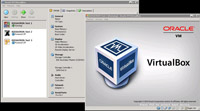Everyday Virtualization
Why I Like VirtualBox
- By Rick Vanover
- 09/01/2010
VirtualBox users are out there and alive and well in the virtualization community -- so much so that the inaugural Virtumania podcast topic was the free type 2 hypervisor. In my virtualization practice, I use VirtualBox exclusively for my type 2 needs. A type 2 hypervisor is a virtualization engine you install on top of an operating system, not as its own installation directly on the hardware like Hyper-V, XenServer or ESXi (now renamed VMware vSphere Hypervisor).
Many people may have naturally chosen VMware Workstation for this need. The fact is that all of the features I need in a type 2 hypervisor are available with VirtualBox, and because VirtualBox is free, I've gravitated there and have been happy with the results.
To give a little history, VirtualBox was a Sun hypervisor product with open source roots. Now that the Oracle acquisition of Sun is complete, the product has remained and is officially called Oracle VM VirtualBox. There are still a lot of questions about the broader Oracle virtualization strategy, but VirtualBox is progressing. The 3.2 release in May 2010 is important for VirtualBox users, as Oracle is apparently committed to the product and has released some great new features:
- Memory ballooning: Typically a feature in type 1 hypervisors, VirtualBox now delivers this memory-management technology. The VirtualBox ballooning implementation exchanges memory to and from guest virtual machines (VMs) dynamically through its powerful command-line interface, VBoxManage. It does not, however, dynamically return memory to the host. Nonetheless, this is a first for the type 2 space.
- Teleportation: VirtualBox allows a VM to undergo a live migration to another host, again through the VBoxManage interface.
- Page Fusion: This de-duplicates memory usage among Windows guests on x64 hosts.
Beyond these new features for version 3.2, VirtualBox has other strong features such as broad virtual disk compatibility.

[Click on image for larger view.] |
| Figure 1. VirtualBox has plenty of features -- and it's free. |
Competing with VMware
All of these features aside, VMware Workstation still has one advantage over VirtualBox that I can't ignore: VMware Workstation can be configured to have a VM run ESX or VMware vSphere Hypervisor as a guest. This is an indispensible testing feature that I use constantly in my home lab, but I use it with VMware vSphere Hypervisor. Many people set up a "datacenter in a box" on a laptop or powerful desktop system; I choose to do that on a server. For my day-to-day private testing on my own desktop system, I'll install VirtualBox over VMware Workstation in all situations.
If you haven't heard much about VirtualBox before now, you should check out the newest version. While it's capable of being a server virtualization solution, I haven't seen it used that way. I and other VirtualBox fans see it as the primary hypervisor on your desktop or laptop to use as a test platform for other OSes. In my experience, this was a lifesaver for co-existing with Windows 7 and Windows XP simultaneously.
Did I mention VirtualBox is free? To be fair, I started with it out of necessity because I'm cheap. VMware Workstation is modestly priced at $189 from the VMware online store, and major upgrades from earlier versions are $99. For me, in this usage situation, VirtualBox is ahead of the game in price, features and usability.
About the Author
Rick Vanover (Cisco Champion, Microsoft MVP, VMware vExpert) is based in Columbus, Ohio. Vanover's experience includes systems administration and IT management, with virtualization, cloud and storage technologies being the central theme of his career recently. Follow him on Twitter @RickVanover.